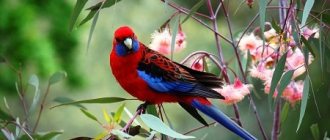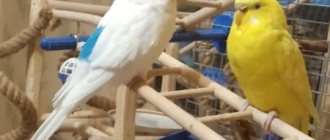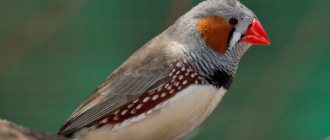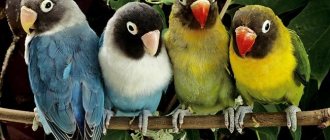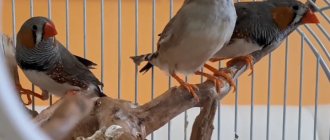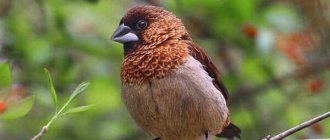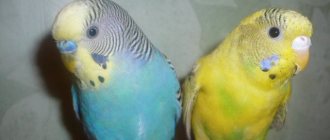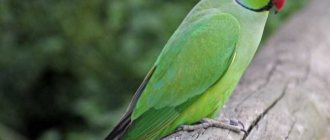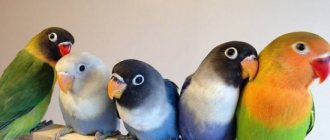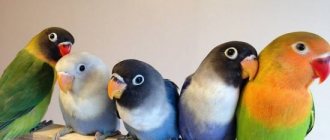Thanks to its beautiful appearance and perky disposition, the New Zealand jumping parrot Kakarik is becoming increasingly in demand. However, there are still few of these birds in Russia. This means that before purchasing it is better to look at the description of kakariki parrots. This will not only prevent possible deception, but will also help in the future to create comfortable living conditions for the new pet.
Description
Kakariki parrots (Latin name Cyanoramphus), also called New Zealand running parrots or jumping parrots, are a genus of birds from the Psittacidae family. An adult individual barely reaches 27-35 cm in length, 10-13 cm of which is in the elongated wedge-shaped tail. The maximum weight of a parrot is usually no more than 100 g.
Types of kakariki parrots
In nature, there were 7 (and according to some sources, 10) varieties of kakariki parrots. Only 4 of them have survived to this day, but even those are susceptible to extinction due to massive deforestation and are protected by the state.
- The red-fronted jumping parrot (lat. Cyanoramphus novaezelandiae) is the most popular kakarik for keeping in captivity. The main color of the plumage is dark green, but during the mutation the bird changed its color to bright yellow. Photos of this particular variety of parrot with changed colors can most often be found on the Internet. The cap on the head and the horizontal red stripe crossing the eyes are characteristic of “New Zealanders” with both color options. A parrot with a natural green color has a blue undertail, and the edging of the contour and flight feathers is the same color.
- The yellow-fronted jumping parrot (lat. Cyanoramphus auriceps) is a bird with bright green plumage. Because of the yellow spot on the forehead, the birds are sometimes confused with drum or shield parrots, although, if you look closely, these two species have little in common. There are small red spots on the rump; a stripe of the same shade adorns the base of the beak. Its tip is black, and the beak itself is bluish.
- The New Zealand mountain jumping parrot (lat. Cyanoramphus malherbi) is a bird that is not in demand for breeding in captivity. Moreover, in nature it is an endangered species, which is listed in the Red Book. Kakarika is characterized by a rich green main color of plumage, which gradually fades in the abdominal area. The parrot's head is crowned with a lemon-yellow cap, which turns into an orange stripe near the beak. The beak is silver with a blue tint.
- The Antipodean jumping parrot (lat. Cyanoramphus unicolor) is the largest of the kakariki. The main color is green, with the area of the sternum, abdomen and undertail having a golden tint. The bird's underwings are blue with a purple tint. The beak is gray, outlined with a black border along the edge.
Red-fronted Jumping Parrots
Yellow-fronted Jumping Parrot
New Zealand Mountain Jumping Parrot
Antipodean jumping parrot
Habitat
Kakariki inhabit New Zealand, as well as some islands. Pacific Ocean. Parrots can live both high in the mountains in wooded areas, and in flat areas in the grass. It all depends on the species.
Birds prefer to spend most of the day on the ground, using their wings only in emergency situations. In search of food, they briskly rake the forest floor with their paws, like domestic chickens. They usually move by jumping, which is why they got their names “running” and “jumping”.
Spreading
Under natural conditions they live on the islands of Oceania. The northern border of the range is the islands of Tahiti and Raiatea. In the south, the habitat reached Macquarie Island in the South Pacific Ocean.
The last island has a rather cold subantarctic climate. Despite this, kakariki were found there until cats were brought to the island at the end of the 19th century.
The center of the habitat is in New Zealand. It is here that birds of these species are most often found. Currently, they are under threat of destruction due to the adverse consequences of human economic activity and poaching.
Two species and two subspecies of these birds have already become extinct.
How to choose a parrot, price per kakarika
It is best to choose a feathered friend in a specialized nursery from specialists who have been breeding kakariki for a long time and know everything about kakariki. They can give recommendations on how to further care for the bird. When purchasing a parrot, you should be guided by the following criteria:
- age (5-6-week-old kakarik chicks adapt best to new conditions. If the parrot has a dull appearance that does not correspond to its variety, it is either younger than stated by the seller or is lagging behind in development);
- appearance (the parrot should have smooth plumage and clear eyes);
- behavior (healthy kakariki, regardless of species, are always very active and do not sit still).
The cost of a “New Zealander” from a breeder varies from 3 to 5 thousand rubles. In a pet store, the price for a kakarika parrot may be somewhat inflated - up to 7 thousand rubles. Also, the price may depend on the region, for example, in a Moscow nursery they may charge you 15 thousand rubles. for a bird.
Purchase
Where to buy a bird, and what is the price? Most pet stores that sell birds have disgusting living conditions. Nobody treats the birds, they are poorly fed, and it would be better to keep silent about the toys in the cages. A jumping parrot sits for days in a cramped cage and suffers from idleness. The price category is too high: they can ask for 7,000 thousand rubles for a bird.
It is easier to purchase a kakarika from a breeder. It's cheaper and quieter for the owner. Don't hand over a sick bird. Finding a breeder is not so difficult; you will have to pay from 3,500 to 5,000 rubles for a bird.
The New Zealand parrot will be an excellent pet for those who can devote enough time to it. When letting a bird fly, you need to keep an eye on it. Considering that kakariki fly for 4-5 hours, it is better to start one for those who can afford to devote that much time to watching the kakariki. If you liked the article or have something to add, then leave your comments and also join our VKontakte group.
Keeping at home
The care and maintenance of New Zealand kakariki comes down to a few simple rules. The main feature of keeping it is to maintain a certain microclimate in the room with the bird.
It is important that the room temperature does not exceed 17-20 ⁰C. Kakarik does not like drafts; the cage with the parrot should not be placed near a working air conditioner.
During the heating season, an air humidifier is installed in the room with New Zealand parrots and the humidity is maintained at 60-70%.
Since kakariki sleep 12 hours a day, if necessary, the daylight hours for a parrot are artificially shortened by covering the cage with a feathered cape.
Arrangement of the cage
The kakarik parrot maintains motor activity throughout the day, constantly moving along the bottom of the cage, along its walls and ceiling. Therefore, the area of a cage or enclosure for one individual, despite the small size of the bird itself, should be spacious. Characteristics of the cage for the New Zealand kakarika:
- minimum dimensions 90×55×90 cm,
- rectangular or square shape,
- with iron bars located horizontally,
- the distance between the rods is 1.5-2 cm.
Taking into account the natural craving of kakariki to constantly dig with their paws in the foliage, a special wood or corn filler is poured onto the bottom of the cage. The cage contains:
- several feeders (preferably hanging ones),
- automatic drinker,
- wooden perches of different sizes,
- ladders,
- rings,
- swing,
- ropes,
- mirror.
Feeding New Zealand parrots
The difference between food for kakariki and the diet of other parrots is that its basis, namely 70%, is succulent food (vegetables, fruits, berries, greens), 20% is given to grain feed (including sprouted) and 10% to animal products origin (cottage cheese, eggs, etc.). The plant diet of kakariki includes:
- clover leaves,
- quinoa,
- plantain,
- woodlice,
- dandelion leaves,
- lettuce leaves,
- yarrow,
- spinach,
- young nettle leaves.
Delicacies for “New Zealanders” are flax and sunflower seeds, corn, nuts, and unleavened cookies. But this kakarika should be fed only occasionally and in very small quantities, for example, as a reward for following commands during training.
What you absolutely cannot feed kakariki is all salty, any heat-treated, fatty, smoked dishes from the master's table. Prohibited foods: chocolate, garlic, potatoes in any form, radishes, coffee, eggplant and avocado.
Care and hygiene
Replacing the filler in the cage, cleaning the feeders and drinking bowls are done daily. General cleaning of the cage, including washing the bars and tray with mild detergents, followed by thorough drying, is carried out once a week. Once every 3 months, the parrot’s home is disinfected using a 0.5% chlorophos solution or 4% bleach. At the end of the treatment, the cell should dry in the fresh air.
New Zealand parrots love to bathe and they should have the opportunity to do this every day. If the bathing suit is in a cage and is freely accessible to the bird, then it is necessary to monitor the cleanliness of the water in it.
Watch in this video how kakariki swim:
Intelligence and abilities of kakariki
Kakariki are active and inquisitive parrots, non-conflicting and get along well with birds of other species. They are not shy, these birds completely lack the instinct of self-preservation. They quickly remember all family members and the objects that surround them. Having recorded information in their heads about where everything is, parrots use it in the future to invent new entertainment for themselves.
Favorites among games: hide and seek, practicing with balls, listening to music and dancing to it. New Zealand kakariki love educational games, for example, putting rings on a pyramid or putting various small objects in a certain place.
New Zealand parrots are extremely curious, they like to retire to secluded corners, this is especially true for females. They can hide and sit silently for a long time somewhere in a closet on a shelf among things, without giving away their presence.
Kakariki often sing and love to sing in the morning, although they are considered one of the quietest parrots. The singing of kakariks resembles whistles and clicks. In general, the voice of the New Zealand kakarika is quite pleasant to the human ear. Birds can imitate musical instruments and remember various melodies they hear.
To learn how kakariki parrots can sing, watch this video:
In addition, males can be taught to speak. They remember words with hissing sounds especially well. True, New Zealand parrots are not known for their talkative nature. They are able to remember only 10-15 words, and there will be problems with clarity of pronunciation.
How to tame a parrot
It is necessary to ensure that the tamed parrots are not distracted by anything, for which purpose there should be no other people or animals in the room during training except the “New Zealander” and his owner. Let's look at how to tame a kakarika parrot step by step:
- To begin with, the New Zealand kakarik must get used to the situation and the new owner, understand that there is no threat from him. To do this, you need to spend as much time as possible every day near the cage with the parrot;
- when the level of trust increases, you can try to slowly, without sudden movements, insert your hands into the bird’s cage, holding them next to the pet for some time;
- then they begin to give the kakarik a treat so that he eats it directly from his hands;
- warm “friendly” relationships with a bird are strengthened by tactile contact - stroking the abdomen or tickling, playing together;
- The final stage in taming will be teaching the kakarika the command to sit on the owner's hand.
Safety
An extremely curious breed - they strive to get into all the cracks. They can get into pockets, shoes, under a blanket, or try to sneak through a crack in a closing door. If the owner does not notice this, he may pinch them, take them out of the apartment in his coat pocket, or lie down on an inconspicuous bulge on the bed. They get underfoot and are easy to step on.
For these curious birds, a hot iron, a running stove, drain holes in sinks and an open toilet lid are dangerous.
Before letting your pet out for a walk, you need to prepare the room and protect the feathered fidget from possible troubles. While walking, you need to keep it in sight and move carefully. If there is no one at home, then kakariki should sit in a cage and not fly around the apartment unattended.
Breeding in captivity
Breeding kakariki parrots at home must be approached with all responsibility, since they are very selective in choosing a partner for mating. Even parrots of different sexes living under the same roof can simply be friends and not develop a romantic relationship.
Attention! The optimal age for breeding offspring is 1 year, although “New Zealanders” reach puberty as early as 4 months.
As soon as the male begins to feed his girlfriend and clean her feathers with his beak, and the female screams in response, crouching in front of him, you can begin to prepare for reproduction. A nesting house with dimensions of about 25×30×35 cm and a hollow diameter of at least 15 cm is installed in the kakarika’s cage.
The female lays 6-10 eggs over several days, the incubation period lasts about 20-25 days. At this time, it is better not to disturb the couple, as New Zealand kakariki become aggressive.
The chicks are born barely covered with gray down and blind. After 10 days, the babies open their eyes, and after 30 days they become fully feathered. At 6-8 weeks, parrots try to fly. At 2.5 months they can already be removed from their parents.
How to distinguish a female from a male kakarika
Jumping parrots have strong sexual dimorphism, so there are no difficulties with the question of how to determine the sex of a kakarika.
- Males are larger than females (about 20 g heavier). They have a wide and weighty beak, the size of the male’s skull is several times larger than that of the female’s head;
- The iris of the eyes of New Zealand parrots is different: in males it is orange, and in female kakariki it is dark brown;
- Boys are talkative, making muttering sounds in order to attract the attention of the owner. Only male kakarikis talk, as mentioned earlier. Girls can remain silent for weeks and only during the breeding season do they begin to call the male to mate.
- Males of kakariki are more active and energetic, females are calm and affectionate.
Behavior
In their habitats, kakariki move along the ground and collect food by raking the litter.
At home, parrots move quickly, are very curious, turn over everything in the cage, and scatter food.
While walking around the apartment, they can pluck indoor plants, walk on sofas and armchairs, and you need to be careful not to accidentally crush the parrot. They are very sociable and constantly require the attention of their owners. To keep your parrot from getting bored, you can buy him a pair. Kakarika has a pleasant singing, similar to whistling; he can remember the music he hears and then whistle it. Only the male can be taught to talk; he can remember 12-15 words.
Poultry diseases and prevention
The New Zealand kakariki parrot is in good health and gets sick mainly due to improper care of its owners. Preventive measures to avoid unpleasant consequences include:
- month-long quarantine for newly acquired birds; if not observed, there is a risk of paratyphoid infection;
- maintaining cleanliness in the cage;
- feeding fresh foods; poor quality food can provoke the development of tuberculosis or poisoning;
- maintaining the necessary microclimate in the room with New Zealand kakariki; non-compliance can lead to colds;
- promoting the breeding of offspring of one couple no more than 2 times a year.
Kakariki parrots suffer from parasites (feather eaters and mites), inflammation of the goiter, and various infectious diseases. Due to the excessive activity of New Zealand parrots, there is a high probability of them getting bruises, fractures and dislocations.
What to feed kakariki when molting? Vitamin supplements and mineral supplements with sand, chalk and sepia are required during this period. A lack of microelements can aggravate the course of molting and extend it over time, which can lead to the appearance of bald spots in a parrot.
